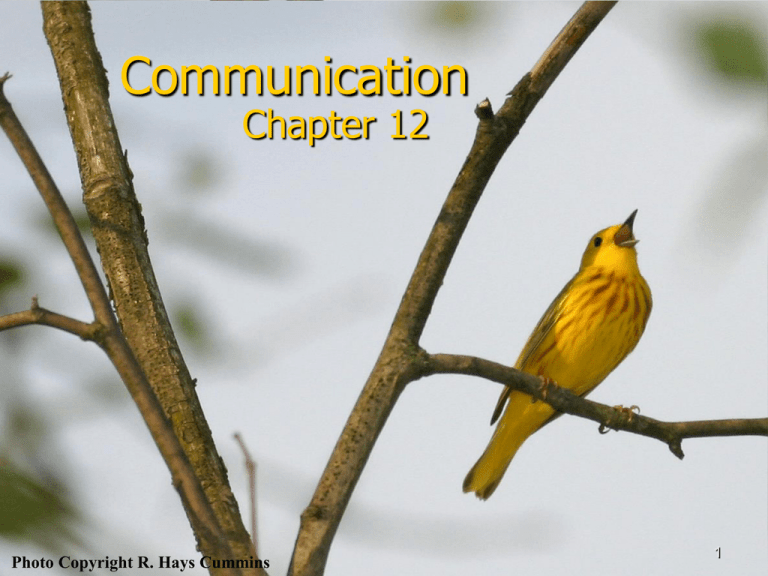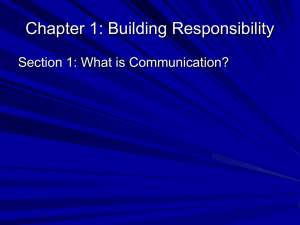
Communication
Chapter 12
Photo Copyright R. Hays Cummins
1
Communication
What is communication?
Types (traits vs. behaviours), classification
How signals convey meaning
Channels of communication (methods)
Functions of communication (purposes)
Complex Communication (bee dance)
2
What is
Communication?
Definition
Types of Communication
States/
Traits
Behaviours
(‘signals’)
How is Communication Classified?
Categories of
Interaction (Wiley)
Other views
3
What Is Communication?
In biology, defined as:
The transfer of information from one
molecule, cell, or organism to another, as by
chemical or electrical signals or by behaviours.
(www.dictionary.com)
All communication involves a “sender” and
a “receiver”
4
Biological Communication
Signal: The physical form in which a
message is coded; any behaviour pattern
that communicates something
Discrete vs. Graded
Discrete: “All or none” (e.g., FAPs)
Graded: Varying in intensity and/or
frequency; provides info about the strength
of stimulus (e.g., Betta splendens display)
5
Discrete signal (ear position)
Graded signal (mouth)
Increasing intensity
6
Biological Communication
Displays are one type of signal
Display: Any behaviour pattern especially
adapted (i.e., modified through evolution)
in physical form or frequency to function as
a social signal in communication
e.g., spruce grouse males beating wings on air
e.g., male dominance mounting in dogs
7
Two male Betta splendens showing fin flare and
operculum (gill) flare
Communicates willingness to fight; allows
assessment of opponent without combat/injury
8
Wiley (1983): Categories of Interactions
Terms used to describe interactions, depending on
the value of the info to sender and receiver
Value of info to RECEIVER
Value of info to
SENDER:
positive
zero (negative)
positive
“True
+/+ “Manipulation”
communication”
(“deceit”) +/0 +/-
zero (negative)
“Eavesdropping” 0/+ “Ignoring” (“spite”)
0/0
-/(“exploitation”) -/+
9
Biological Communication
How to classify/define communication?
Value of information to each participant
Cost & Benefit Analysis
• Both benefit = true
communication;
male bird song during mating
season
• Sender benefits, receiver is
unaffected or harmed = deceit or
manipulation; e.g., killdeer
performing “broken wing display”
10
Biological Communication
Deceit
Interspecific deceit more
common
predator-prey
relationships
Aquatic predators that
attract prey using lures
that look like insects
® Disney, Finding Nemo
Intraspecific “deceit”
unlikely to spread in a
population, except…
11
Categories of Interactions
Sender benefits, receiver is
harmed (+/-):
Deceit
Another example:
“femme fatale” fireflies –
females pretend to be
receptive, attract and
consume males of another
species
http://www.ebertfest.com/two/grave_fireflies_bluebat.jpg
12
Biological Communication
Value of information to each? Cont’d
Sender unaffected or harmed, receiver benefits =
exploitation or eavesdropping;
mouse rustles grass as running, allowing owl to hear
it, catch it & eat it
Neither benefit, both may be harmed =
ignoring or spite;
a bird ignores the cryptic colouration of a moth and
tries to eat it
Monarch Butterfly
13
Biological Communication
Other ways to view communication:
Communication need not benefit
both sender and receiver since
natural selection operates mainly
at the level of the individual
(Dawkins & Krebs);
Displays evolve to “waste” a
minimum of energy of sender…
persuade the receiver, not
“inform” (exaggeration and
redundancy of signals);
roar of male lion
14
Biological Communication
Other ways to view communication:
Displays – have evolved to maximize the
effectiveness of information transfer, to the
benefit of both sender and receiver
coevolution of signals; each species acts as a
strong selection force on the other;
Problem: this definition cannot encompass
“lying”
15
How Signals Convey Meaning
Distance & Duration (signal type)
Can travel far (e.g. scent), or operate over
short distances (e.g., visual signals)
Can be long-lasting (e.g., pheromones entire
breeding season) vs. short-term (e.g., calls/
vocalizations)
16
How Signals Convey Meaning
Individuals can increase information
content of signals by… combining 2+
signals = composite signal
Zebra: meaning of “open mouth” signal
depends on ear position (forward = friendly;
backwards = hostile)
…changing syntax, or sequence of displays
A before B is NOT = B before A
17
How Signals Convey Meaning
Information in a signal can be context-
dependent;
E.g., “lion’s roar” : aggressive, maintaining
contact with pride members, or indication to
neighbours to keep a good distance
18
Types of Communication
(How can a message be sent?)
States or Traits:
Sign stimuli – Ch.’s 2 & 10
Aposematism & Batesian mimicry – Ch. 15
Indicator traits – Ch. 17 (to come)
Behaviours: (i.e., “does”)
Signals
Some FAPs
Displays
19
Sign Stimuli
Three-spined stickleback (Ch. 2, p. 15)
Enlarged belly of female = Sign stimulus
(honest sign that female is ready to spawn)
20
Sign Stimuli
Not a behaviour, a state (e.g., enlarged
belly)
May provide info about physical state of
bearer
NOTE: Not all sign stimuli convey
information, and not all FAPs act as signals
E.g., egg retrieval in gulls
If info is exchanged between conspecifics when
sign stimulus or FAP occurs = communication
21
Aposematism (warning colouration)
Conspicuous markings of noxious animals
are easily recognizable and avoidable by
predators
Convey information about unpalatability
Batesian mimicry = manipulation/deceit
(lying)
pinker.wjh.harvard.edu/
photos/santa_barbara_c...
http://www.rockleigh.org/Recreation/Images/Mammal/skunk.jpg
22
Communication
What is communication?
Types (traits vs. behaviours), classification
How signals convey meaning
Channels of communication (methods)
Functions of communication (purposes)
Complex Communication (bee dance)
23
Channels of
Communication
Odour
Sound (ultrasonic, sonic, and infrasonic)
Seismic vibrations
Touch
Electric field
Visual
24
Properties of Sensory
Channels
Range (distance covered) – short to long
Transmission rate (how long does it take to get
from sender to receiver?) – slow to fast
Can it travel around objects? – yes or no
Can it be used at night? (yes, no, or sometimes)
Fade-out time (how long does it last? – slow to
fast)
Locate sender? (easy to difficult)
Cost to send signal (low to high)
Complexity of message (low to high)
25
Audition: Properties
Auditory communication
Range?
Travels around objects?
Yes
Fade-out time?
Yes
Useful at night?
long
Fast
Cost to sender?
High
26
Odour
Used by most species (evolutionarily
“old”)
Usually involves pheromones:
a species-specific odour cue released
by animals that influences the
behaviour and/or physiology of
conspecifics
27
Odour
Functions:
Group spacing – marking territories
Recognition – identifying conspecifics,
kin, individuals
Reproduction – attracting mates,
altering physiology (e.g., levels of sex
hormones)
Alarm – fear pheromone (e.g., inverts)
28
Odour
Pheromones often present in
urine of mammals (& anal
glands)
Two types:
priming (generalized
response)
signaling (immediate
specific response)
“Flehmen” response
(vomeronasal organ)
29
Odour: Properties
long range
slow transmission rate
travels around objects
useful at night
slow fade-out time
low cost to sender
unable to locate sender
simple message only
30
Sound
Can occur within or outside of human
“umwelt” (~20-20,000 Hz)
ultrasonic (high frequency - e.g., echolocation)
infrasonic (low frequency - e.g., African
elephant rumbles, whale song)
31
Sound
Can be produced by:
a single organ
(vocalizations)
stridulation (e.g., cricket
“chirp”)
other means (e.g.,
drumming by Northern
Flickers/ woodpeckers)
32
Seismic Vibration
Substrate-borne vibrations detected by
animals
White-lipped male frogs make thumps,
females extremely sensitive to vibrations
Spiders catch prey by detecting vibrations
Male orb-weaving spiders “pluck” at web to
bring female out for mating
33
Sound/Vibration Properties
long range
fast transmission rate
travels around objects
useful at night
fast fade-out time
high cost to sender
may be able to locate sender
sound = complex message,
vibration = simple message
34
Touch
Tactile communication (physical contact)
Common in invertebrates: Antennae, tube
feet, etc. (also pick up chemical cues)
Vertebrate copulation tactile stimulation
elicits lordosis response in female mammals
Touch (e.g., vaginal stimulation) can induce
ovulation in some species (induced
ovulators)
35
Touch: Properties
short range
fast transmission rate
can’t travel around
objects
useful at night
fast fade-out time
low cost to sender
easy to locate sender
Simple message only
36
Visual Communication
Markings, patterns, colour require vision
Mostly used by diurnal species (visual
displays), e.g., aggressive displays of SFF
Exception: fireflies
species-specific flashing to attract mates and
during courtship
“femme fatales” of Photuris versicolor
(deceit)
37
Vision: Properties
medium range
fast transmission rate
can’t travel around objects
little use at night
fast fade-out time
cost to sender medium
easy to locate sender
allows complex messages
38
WhoZoo(http://whozoo.org)
Electric Field
Some sharks and electric fish detect prey’s
electric field using electroreceptors
Strongly electric fish (e.g., electric eel) have
EODs (electric organ discharges of 100’s V)
Social communication possible by altering
wavelength/ pulse duration
39
Electric Field: Properties
short range
fast transmission rate
travels around (and through) objects
useful at night/in murky water
fast fade-out time
cost to sender varies
easy to locate sender
Simple message only
40
Functions of Communication
1.
2.
3.
4.
5.
6.
7.
8.
9.
Group spacing & coordination
Recognition
Reproduction (identifying/attracting mates)
Agonism and social status
Alarm (warning)
Finding food
Soliciting play
Giving & soliciting care
Synchronization of hatching
41
Functions of Communication
Group Spacing & Coordination
Spacing signals of primates:
Distance-increasing (branch shaking)
Distance-maintaining (dawn chorus)
Distance-reducing (contact/lost calls)
Proximity-maintaining (social grooming)
42
Functions of Communication
Recognition
Species Recognition
Neighbour Recognition
Individual Recognition
Kin Recognition
43
Functions of Communication
Reproduction
Courting displays, copulation- allow
assessments of species, physical condition,
“quality” of mate
44
Indicator Traits
(Sexual Selection – Ch. 17)
Provide info to members
of the opposite sex about
the physical condition of
the bearer
Choosier sex (usually
females) show
preference for most
extravagant traits
E.g., brightest colours,
largest antlers, longest
tail feathers, etc.
45
Keeping signals HONEST:
Zahavi & Zahavi’s “Handicap Principle”
If signals are costly to
produce (peacock tail),
they tend to be
honest indicators of
condition or ability
(i.e., in good health,
well-nourished and
free of parasites)
(sexual selection)
46
Functions of Communication
Social Status/ Agonism
Dominance/submissive displays- avoid costly
fighting
Traits may also indicate social status (bigger,
stronger males perceived as dominant) e.g.,
antler size in moose
wolves and dogs
47
Functions of Communication
Alarm
Altruism or Selfishness?
•Alarm calls are given to
warn other individuals
about the presence of a
nearby predator and are
usually directed toward
close kin.
•giving an alarm call
increases the chance that
the predator will attack
the caller
Female Belding's ground squirrel
(Spermophilus beldingi) emitting
an alarm call. (Sherman)
48
Functions of Communication
Alarm
Vervet monkeys: Seyfarth & Cheney
“semantics”- different calls for different predators
(avian, ground)
Pheromones as chemical alarm substances
inverts; mammals
Sea urchins steer clear
of an area where a urchin
has just been crushed
49
Functions of Communication
Finding Food
“Information Centre Hypothesis”
colonial organisms
(e.g., communally roosting weaver
birds)
hunting packs
(African wild dogs)
Giving/Soliciting Care, Play;
Synchronization of Hatching
(precocial birds – vocalize prior to
hatching)
50
Evolution of Displays
Communicative displays are believed to
have evolved from noncommunicative
behaviours through the process of
ritualization:
Ritualization = Evolutionary process by
which behaviour patterns become modified
to serve as communication signals.
51
Ritualization (example)
•
•
Food calling behaviour still seen in
roosters may be evolutionary origin of
courtship display seen in peacocks
i.e., peacocks’ ancestors may have
performed food-calling behaviour, which
became ritualized into bow/feather spread
display presently used
52
Evolution of Displays
“freezing” of movement into
postures
Stereotyping of behaviour
(stays constant even under
different levels of motivation)
Development of conspicuous
body structures- enlarged
claws (fiddler crab),
ornamental feathers
(peacocks, male ducks),
manes (lion), exaggerated fins
(Betta)
Crested Auklet (I. Jones)
53
Displays may have arisen from…
Intention movements - e.g., “powk” calls
of BL Kittiwakes -- gannets
OR
Displacement activities- innate,
stereotypical responses to stimuli that
seem inappropriate to the situation
Some degree of conflict in organism’s
motivation- e.g., strange female approaches:
is a sexual or agonstic response needed?
54
Displacement Activities
Evolved into courtship display: During
courtship, males may preen or touch
own feathers (sham preening)
Conspicuous feathers (sailfeathers) may
have evolved and are exposed during
this behaviour
Mandarin Duck
www.feathersite.com
55
Other origins
of displays:
Receiver bias - the
increased sensitivity of
perceptual systems to
certain stimuli as a result of
natural selection
Such biases may influence the evolution of
communicative displays
E.g., insect feeds mostly on yellow flowers,
adapted to be sensitive to yellow in general,
males with yellow are preferred, and may
exploit this to attract females
56
Complex Communication
57
Honeybee communicative
dances
“Round Dance”
Food nearby; less detailed
“Waggle Dance”
Food >200m away;
more detailed
58
Photo Caption: Diagram of the honeybee dance. (Credit: P. Kirk Visscher.)
•Ceiling of hive = direction of sun (reference)
Angle of straight run (on vertical) = direction of
food source relative to sun
59
•direction and duration of the straight run is critical
•antennae of hive members maintain contact with the dancer
60
and taste samples of regurgitated food









